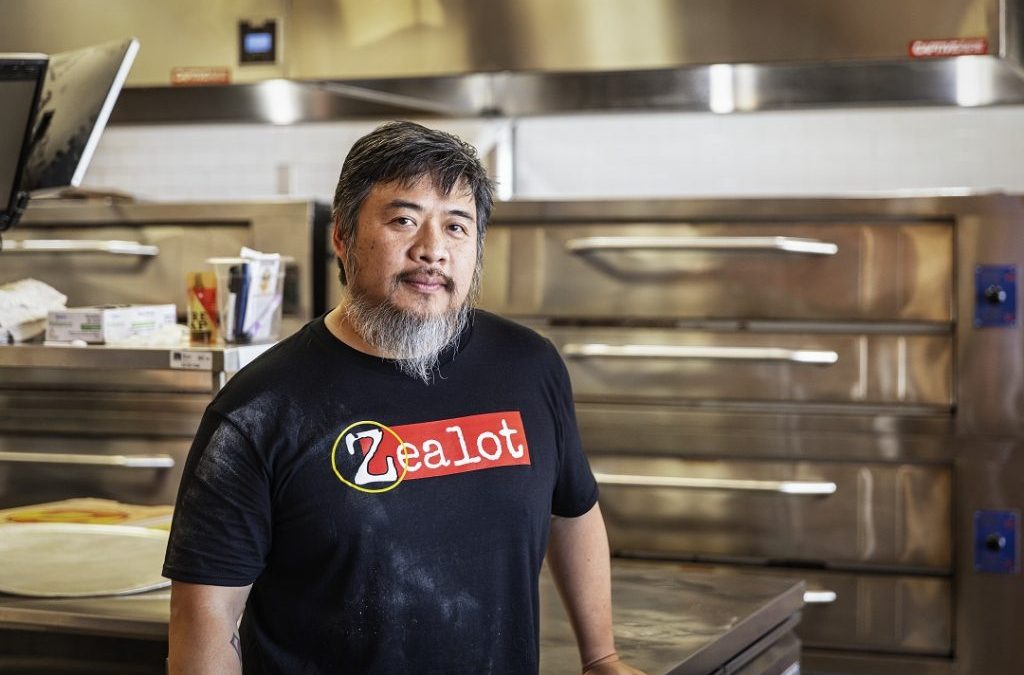Zalat Pizza founder Khanh Nguyen is a self-professed pizza zealot. Once a lawyer, a tech founder and then a pizza-pie innovator, he’s exceptionally focused on making some of the very best pizzas in the Dallas area. He also thinks of himself as the very first restaurant to partner with Uber.
“We have a lot of pizzas and that’s all we do. Our one appetizer is a pizza. We don’t even want to take the time to do a fountain soda, that will take some time and effort. So we just pull Coke cans out of the cooler and Ben & Jerry’s out of the freezer,” said Nguyen. “It’s all handmade, we’re making 1 million pizzas a year in mass volume. Every single pizza, since we don’t use a conveyor belt, every pizza has a chance for failure or greatness.”
He admitted he has one salad, but it’s all about the pizza at his 20 current locations. Making the paragon Nashville Hot Chicken and Pickles pizza or getting the perfect pesto swirl on the Pesto Veggie is a high-stakes, high-quality endeavor. Nguyen said he spends a lot of money on the best mozzarella, makes all the dough in house and went on a pepperoni pilgrimage to find the ideal all-beef pepperoni.
As for the business model, he tweaked that, too. To get “fanatical buy-in” from his staff of fellow pizza zealots, he offers full benefits, 401(k) for all staff, a company tattoo after a year. He gets a staff comic book made every year, too, with employees as the heroes. But there aren’t any drivers, which is the biggest pivot away from the traditional pizza model.
“We started configuring it like a small pizza shop. We had our own delivery system going in the beginning, we realized right away–within the first week or two– holy smokes, all the chains they’re not pizza companies, they’re delivery companies. Just look at where they spend their money and their focus, because it takes an incredible amount of effort to get those pizzas out the door,” said Nguyen. “We realized right away, if we’re going to be ultra-focused on one product, we can’t have that mission diverted by the greater mission of getting the pizza out the door.”
He started making plans to disentangle Zalat from the delivery business, but back in 2015 and early 2016, there were no options. Uber had just reached Dallas, ferrying people, not pizza. But Nguyen tried, and that’s where the legend of the first Uber restaurant started.
“Whenever we got overloaded, meaning too many deliveries for the drivers we had. I started calling up Uber drivers,” said Nguyen. “We’d walk the pizza out and we’d have a two- to three-minute conversation with them to convince them. We’d talk three of four drivers into it, one of four would cuss us out–we definitely pissed off some drivers.”
It wasn’t a bad ratio, but it didn’t exactly solve his delivery problem. As he tells the story, he reached out to Uber, made the pitch to Uber’s general manager of Texas to deliver food with the network of thousands of drivers. It was a somewhat novel idea back then; it was early days for Postmates, even.
“He took it back to San Francisco, and about three weeks later he said we have this little piece of software to deliver flowers from some shops. We think we can modify it for food delivery and we’re interested in taking you up on your offer to be the alpha on this thing,” said Nguyen.
He said Uber flew in a team to get things going while things were buggy, it was a transformational little piece of software.
“We got started on a Monday, and by Friday, I shut down all our own delivery operations. I switched over to them 100 percent,” said Nguyen. “That was Uber Rush that they created with our help and that became Uber Eats.”
Since being, as he said, Uber’s single restaurant partner for three or four months, he’s used the same model at all his locations.
The timeline is a bit murky for Uber, but Meghan Casserly, head of communications overseeing delivery at Uber, said the legend of Zalat and Uber rings as true as memory serves.
“While tracking sign-ups to the minute is tricky, Zalat Pizza was definitely among the first—if not the very first—restaurant partners in the Dallas Fort Worth area, long before the Uber Eats app existed, and have been valued since day one,” said Casserly. “The original history of what pre-Eats brand name launched where is a matter of company lore (and is often debated!), but the team in Texas prizes Kahnh and the team at Zalat’s longtime partnership, so we’re proud to call them our first.”
When asked for tips to thrive on the third parties, Nguyen said it’s tougher today. Clearly, there are a lot more restaurants on the platform than just him today, but he said the laser focus on quality and great operations is No. 1.
“You’ve gotta be really good. Just like social media rewards eyeballs, the third parties will reward you for having a great product because they want repeat business too. They want a great product and you’ve got to be very, very good from an operational standpoint,” Nguyen added.
He said a successful third-party partner can’t miss items, send out poor quality food. He currently has 4.5 or higher rating at all his locations from customers. He also values the drives and ensures they’re not standing around.
“They can do an extra delivery ever 20 to 30 minutes. If they’re waiting 20 minutes, you’re eating up a huge portion of their driver pay. They track all this stuff and rank you accordingly and will give you certain designations if you’re the best,” said Nguyen.
One very apparent nod from drivers, they line up and idle in front of his restaurants, ready to pounce on the next order.


